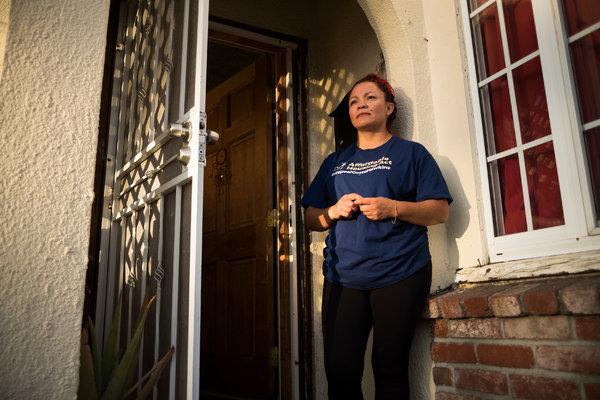|
| “And yet economists from both the right and the left are in almost universal agreement that rent control makes housing problems worse in the long run. Here’s what’s behind their thinking and the nuances of the debate. “
Why Rent Control Is a Lightning Rod
Proposition 10 in California has put a new focus on an old question: whether rent control tends to ease or compound a shortage of affordable housing.

Eva Jimenez, an Oakland, Calif., tenant, is a member of the Alliance of Californians for Community Empowerment, which is running the “Yes on 10” Campaign with the AIDS Healthcare Foundation. Credit Brian L. Frank for The New York Times

By Conor Dougherty
Oct. 12, 2018
·
A supply of housing sufficient to meet urban needs in California will not be built for decades, if ever, and right now building doesn’t seem to be helping much. Many of the newer rental buildings carry high-end prices, while stock of affordable housing is actually falling.
Given that, rent control is an easy and off-the-shelf policy tool that many people are familiar with — one that does help some renters and doesn’t appear to cost taxpayers money. “It is the best anti-displacement tool around,” said Stephen Barton, co-author of a recent report that called rent control a key measure toward stabilizing California’s housing market.
And yet economists from both the right and the left are in almost universal agreement that rent control makes housing problems worse in the long run. Here’s what’s behind their thinking and the nuances of the debate.
What does rent control do?
Rent control or rent-stabilization laws are city-level prohibitions on rent increases beyond a certain amount. They are rare nationwide — 37 states prohibit their cities from enacting such laws — but have existed for decades in places including New York, Los Angeles, San Francisco and Washington.
What is Proposition 10?
Proposition 10 is a California voter initiative that would repeal a 1995 law called the Costa-Hawkins Rental Housing Act. The law prevents localities from enacting certain forms of rent control. Notably, it exempts single-family homes from rent control laws, along with apartments built after 1995. It also prevents something called vacancy control, allowing landlords to raise the rent without limit whenever a tenant under rent control moves out.
How does vacancy control work?
Let’s say a tenant is paying $1,000 a month and the market rate is $2,000 a month. Under current law, when the rent-controlled tenant moves out, the landlord is free to charge the next tenant $2,000 (or any other amount). Under vacancy control, the rent increase would still be regulated and could go up only by the percentage allowed by the local law. If the Costa-Hawkins law is repealed, cities could theoretically prevent landlords from ever charging market-rate rents, although there is almost no chance of that prospect on a large scale.
What happens if Proposition 10 fails?
Rent control is still legal for a large share of California’s housing stock, and tenants continue to organize rent control drives up and down the state. It’s possible, even likely, that more California tenants will win some form of rent control sometime in the next few years, regardless of what happens with Proposition 10. The main question is what units these laws will apply to and how stringent the rules will be.
What happens if Proposition 10 passes?
Proposition 10 would repeal a state law that prevents local laws, but it wouldn’t make new law itself. If it passes, cities could enact more stringent and expansive rent control laws, and some are already looking into it. But they don’t have to, and many won’t.
What are the arguments for and against the initiative?
Tenants’ rights organizations argue that California’s affordability crisis demands more rent-controlled units, as well as tools like vacancy control. They say the disparity between rent-controlled units and market rate prices encourages landlords to evict poorer residents in favor of people who can pay more. Vacancy control could prevent this by regulating the rent regardless of who lives there: Why would landlords push tenants out if they couldn’t raise the rent for the next person?
On the other hand, most studies show that even though rent control is great for tenants who get it, the policies can lead to higher rents and fewer units over all.
Is that why economists say rent control can make housing problems worse?
Yes. That said, nuance is something you’re unlikely to hear in side’s political. One of the more frequently cited studies is a Stanford analysis that found that rent control accelerated the gentrification of San Francisco’s Mission District by encouraging landlords to convert rental housing into higher-end condominiums and cooperatives. The study also concluded, however, that rent control lived up to the promise of reducing the displacement of lower-income tenants and older people.
Economists have three main criticisms of rent control. They say it helps renters today at the expense of renters tomorrow. They also see it as a blunt instrument: While helping to stem economic displacement in the short term, it leads to long-run problems by encouraging landlords to exit the rental business, and future landlords to not enter. And it can divert resources from low-income renters to those with moderate and even high incomes. In a 2002 study, San Francisco found that about a quarter of its rent-controlled units were occupied by households with incomes over $100,000. That number has to be much higher today.
What do some economists think cities should do instead?
Build more housing. California is one of the nation’s most heavily regulated building markets, and has underproduced housing for decades. The state ranks 49th of 50 (above Utah) in the number of housing units per capita. Fewer homes = higher prices.
Of course, this won’t do much for renters who are struggling now. To that end, a number of economists have suggested subsidies or tax credits as an alternative to rent control, because they can shield renters from big price increases while being tailored to people who need the most help.
“When people need health care, we give them Medicaid, and when they need food, we give them food stamps,” said Christopher Palmer, an economist at the Massachusetts Institute of Technology. “But for housing, another basic human need, we tell people to get on a list and maybe in 10 years they’ll get a voucher for an apartment. That doesn’t match up with the immediacy of the need.”
Mr. Palmer’s studies have suggested that rent control distorts the housing market. But like many other economists, he is not opposed to greater government efforts to help renters. The debate is about how to do it.
Is there another way?
Expanding vouchers and tax credits would require spending billions of dollars a year, a prospect that is not realistic any time soon. Recognizing this, the Terner Center for Housing Innovation at the University of California, Berkeley, has suggested that California adopt an anti-gouging measure that would cap rent increases at 10 percent a year and apply to all homes in the state, not just those covered by local rent control laws.
“A middle-ground solution is critical because we cannot have a situation where we disinvest in rental housing at a time when we absolutely know we need it, and yet we have people who are being displaced and suffering, and that is not acceptable, either,” said Carol Galante, faculty director of the Terner Center.
Conor Dougherty is an economics reporter. His work focuses on the West Coast, real estate and wage stagnation among U.S. workers. He previously worked at The Wall Street Journal, the San Diego Union-Tribune and The Los Angeles Business Journal. @ConorDougherty
A version of this article appears in print on Oct. 12, 2018, on Page B2 of the New York edition with the headline: Why Rent
|

